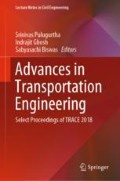Abstract
In homogeneous form of traffic, the vehicles in traffic are not so versatile and the vehicles move in dedicated lanes, whereas in countries such as India, the form of traffic is heterogeneous in nature where the traffic is very versatile with many combinations of vehicles which rarely move in dedicated lanes. The combinations make it harder to calculate the headway, PCU, etc. because every vehicle possesses a different shape and size. The lack of use of dedicated lanes makes it very tough to check which vehicle belongs to which queue and how it will move or accelerate. Hence, the methodology used for homogeneous traffic condition fails drastically when used in heterogeneous traffic conditions. The recent researches based on heterogeneous form of traffic do not present us with a reliable methodology to compute or calculate the saturation flow in heterogeneous traffic condition. This makes it difficult to design and plan the working of intersections because the traffic almost always tends to move differently than the calculated outcome. The current research is primarily focused on the development of a reliable methodology which can present us with a more accurate saturation flow traffic data, i.e. intersection capacity in heterogeneous traffic conditions. In the clearance method, different factors such as effective turning radius, projected area of the vehicles, etc. are required for the calculation of saturation flow. In velocity method, during a traffic jam all the vehicles are almost at the same speed so the PCU deviates from its actual value making all PCU values of different vehicles almost the same. In India, we have heterogeneous type of conditions not homogeneous and also the lane discipline is not followed. In this clearance method, the study considers only a particular type of vehicle at an instance and we have to determine the clearance time it requires, i.e. the time it takes from curb line to front curb line.
Access this chapter
Tax calculation will be finalised at checkout
Purchases are for personal use only
References
TRB (2010) Highway capacity manual, 5th edn. Transportation research record. Transportation Research Board, National Academy, D.C.
Transport and Road Research Laboratory (1963) A method of measuring saturation flow at traffic signals. London, U.K
Indian Roads Congress (1994) Guidelines for the design of at grade intersections in rural and urban areas. IRC Code Pract. SP41
Hossain M (2001) Estimation of saturation flow at signalised intersections of developing cities: a micro-simulation modelling approach. Transp Res Part A Policy Pract 35:123–141. https://doi.org/10.1016/s0965-8564(99)00050-6
Hadiuzzaman M, Rahman M, Karim MA (2008) Saturation flow model at signalized intersection for non-lane based traffic. Can J Transp 2
Rahman M, Nur-Ud-Deen S, Hassan T (2005) Comparison of saturation flow rate at signalized intersections in Yokohama and Dhaka. Proc East Asia Soc Transp Stud 5:959–966
Bonneson J, Nevers B, Zegeer J, et al (2005) Guidelines for quantifying the influence of area type and other factors on saturation flow rate. Texas
Gates TJ, Noyce D (2010) Dilemma zone driver behavior as a function of vehicle type, time of day, and platooning. Transp Res Rec J Transp Res Board 2149:84–93. https://doi.org/10.3141/2149-10
Biswas S, Chakraborty S, Ghosh I, Chandra S (2018) Saturation flow model for signalized intersection under mixed traffic condition. Transp Res Rec 0361198118777407. https://doi.org/10.1177/0361198118777407
Biswas S, Ghosh I (2018) Modeling of the drivers’ decision-making behavior during yellow phase. https://doi.org/10.1007/s12205-018-0666-6
Chandra S, Kumar U (2003) Effect of lane width on capacity under mixed traffic conditions in India. J Transp Eng 129:155–160. https://doi.org/10.1061/(asce)0733-947x(2003)129:2(155)
Biswas S, Ghosh I, Chandra S (2017) Influence of signal countdown timer on efficiency and safety at signalized intersections. Can J Civ Eng 44:308–318. https://doi.org/10.1139/cjce-2016-0267
Author information
Authors and Affiliations
Corresponding author
Editor information
Editors and Affiliations
Rights and permissions
Copyright information
© 2019 Springer Nature Singapore Pte Ltd.
About this paper
Cite this paper
Biswas, S., Prasad, H., Jaiswal, A., Gehlot, A.R. (2019). Estimation of PCU and Saturation Flow at Signalised Intersection. In: Pulugurtha, S., Ghosh, I., Biswas, S. (eds) Advances in Transportation Engineering . Lecture Notes in Civil Engineering , vol 34. Springer, Singapore. https://doi.org/10.1007/978-981-13-7162-2_4
Download citation
DOI: https://doi.org/10.1007/978-981-13-7162-2_4
Published:
Publisher Name: Springer, Singapore
Print ISBN: 978-981-13-7161-5
Online ISBN: 978-981-13-7162-2
eBook Packages: EngineeringEngineering (R0)

